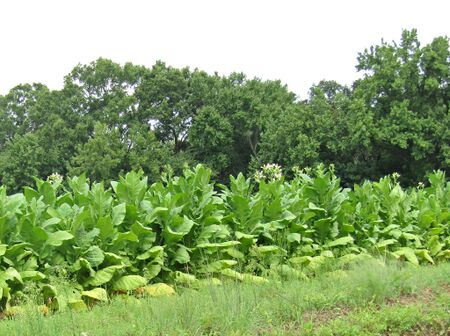Bright Leaf (tobacco)
Bright Leaf is a strain of tobacco. It is called "bright" because when dried it has a yellowish or orangish hue. The crop requires a heavy use of fertilizers.[1] The regions where tobacco is grown in the Atlantic coast region of the United States are divided into "belts", depending on the nature of the soil, and other conditions. What used to be known as the "old belt", is now known as the "bright belt".
In 1948, Foster Fitzsimmons published a novel about the Tobacco Industry in the late 19th Century, entitled "Bright Leaf". In 1950, a feature film based on the novel, also entitled "Bright Leaf", was released.[2][3][4][5] In 2003, Ross McElwee released a personal documentary, entitled "Bright Leaves", exploring whether his family history with the Tobacco industry intersected with the novel and film.[6][7][8]
References
- ↑ Robert E. Williams. FOUR STATES DECIDE TOBACCO SITUATION; Bright-Leaf Acreage Reduction Abandoned by Governors at Charlotte Meeting. SMALLER CROP EXPECTED Opposition of North Carolina's Executive Settles the Matter --Cotton Also Discussed. Tobacco Position Settled. Expect Smaller Crop., New York Times, 1931-11-15, p. E6. Retrieved on 2022-08-30.
- ↑ Jack Pendarvis. The Cigarette Lighter, Bloomsbury Publishing, p. 15, 51-52, 111. Retrieved on 2022-08-30.
- ↑ William T. Polk. REVIEW OF NORTH CAROLINA BOOKS OF THE YEAR, The North Carolina Historical Review, April, 1950, p. 200-204 (5 pages). Retrieved on 2022-08-30.
- ↑ Lawrence Lee. Tobacco Is King!; BRIGHT LEAF. By Foster Fitz-Simans. 631 pp. New York: Rinehart & Co. 63.50., New York Times, 1948-10-03, p. Book 25. Retrieved on 2022-08-30.
- ↑ Bosley Crowther. THE SCREEN IN REVIEW; 'Bright Leaf,' With Gary Cooper as Tobacco Magnate, New Bill at Strand Theatre, New York Times, 1950-06-17, p. L7. Retrieved on 2022-08-30.
- ↑ Stephen Holden. FILM FESTIVAL REVIEW; Tapestry of a Family and Its Home State, New York Times, 2003-10-11, p. B16. Retrieved on 2022-08-30. “McElwee family lore has it that the movie, directed by Michael Curtiz and adapted from a novel by Foster Fitz-Simons, is the story of his great-grandfather. And it prompts Mr. McElwee to embark on an eccentric quest to document the connection. He obsessively reruns the movie and interviews a film scholar, Vlada Petric, along with Ms. Neal and the original novelist's widow.”
- ↑ James Ryerson. FILM; Cigarettes, Gary Cooper And Me, New York Times, 2004-08-22. Retrieved on 2022-08-30. “The film is set in motion when Mr. McElwee learns of the existence of a 1950 Hollywood melodrama called Bright Leaf, starring Gary Cooper, Lauren Bacall and Patricia Neal, about a rivalry between two tobacco growers in post-Civil War North Carolina. At the suggestion of a cousin, Mr. McElwee becomes convinced that the character played by Cooper is based on his great-grandfather, John Harvey McElwee, a North Carolina tobacco tycoon who was ruined and run out of the business by his nemesis, James Buchanan Duke (whose legacy would encompass both the American Tobacco Company and Duke University.)”
- ↑ FILM REVIEW; Romance of Tobacco Brought to Life, New York Times, 2004-08-25, p. E4. Retrieved on 2022-08-30. “His great-grandfather was a tobacco king who created the Bull Durham brand, then lost his fortune to a rival clan, the Dukes, who became North Carolina royalty. Through a cousin who collects vintage films and movie memorabilia, he becomes fixated on a 1950 black-and-white melodrama, Bright Leaf, about the tobacco wars of the late 19th century, starring Gary Cooper, Lauren Bacall and Patricia Neal.”
